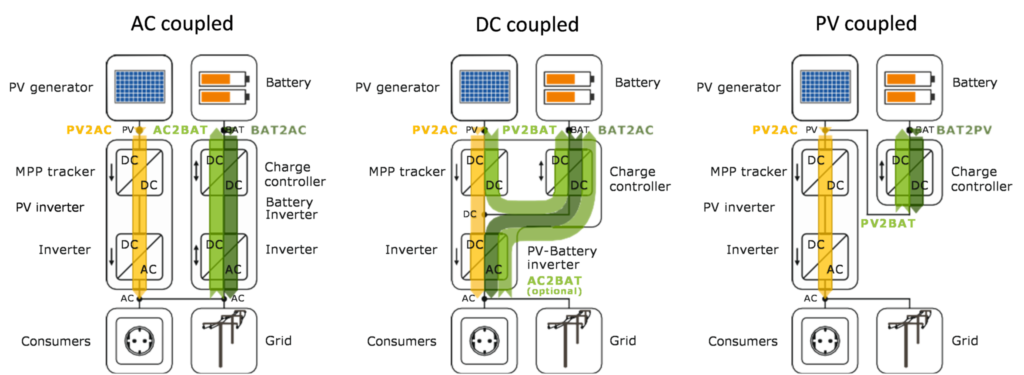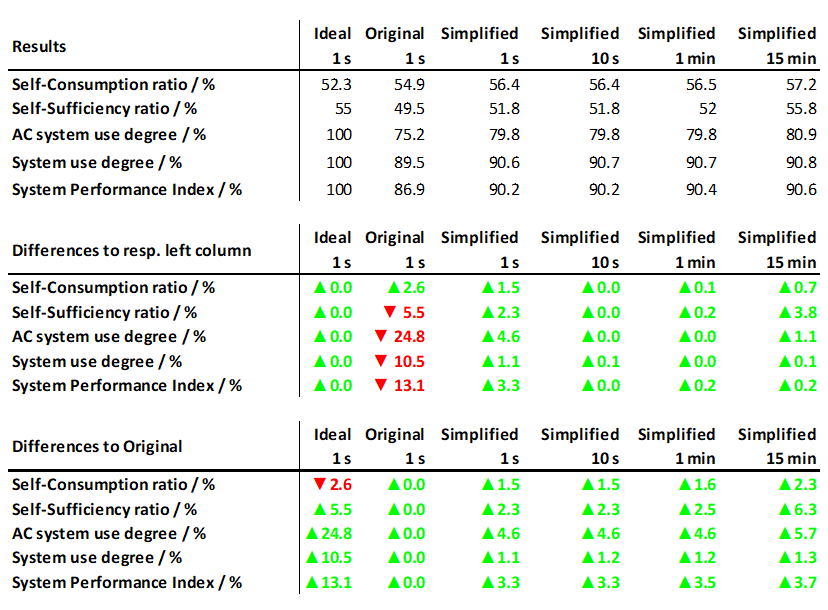Performance “PerMod” simulation model
Polysun’s default battery computation model is based on the open source Performance model “PerMod” for the simulation of battery systems by (Weniger & Tjaden). A full documentation including Matlab source code is available at http://pvspeicher.htw-berlin.de/permod.
This subsection briefly describes the simulation model and the simplifications that were made compared to the original model, in order to allow a parameterization of PV battery systems using measurements based on the BVES Efficiency Guideline.
Computation model
Instead of assuming constant efficiencies like many battery system models, PerMod computes the power losses of the individual components as a quadratic function of the power input or output, respectively. The following figure depicts the efficiencies and power losses as functions of the normalized power output while charging for two exemplary PV storage systems.

The power loss curve can be adequately fitted as
\(a \cdot p^{2} + b \cdot p + c\)
with the specific power \(p = \ \) (power output / nominal power output) and the fitted parameters \(a,\ b\ \) and \(c\) .The efficiency \(\eta(p)\) is equal to
\(\ \eta(p) = \ 1 – \frac{p_{loss}}{p}\)
where \(p_{loss}\ \) is the power loss in W/kW. On PV storage systems’ data sheets that comply with the BVES efficiency guideline, curves are depicted for the applicable energy conversion paths illustrated in the following figure.

Once extracted (e.g., by using a curve fitting tool), the power loss coefficients can be entered into Polysun’s PV inverter and battery inverter catalogues, respectively (see the following figure). If only one conversion path is specified in the catalogue entry (as is the case for most entries in the following figure), Polysun assumes that the power loss function is the same for the unspecified path.
Hint: It is must be noted that the efficiency of an inverter depends not only on power, but also on voltage. Since PerMod only regards the power as an input to the efficiency function, an inverter may have different polynomials depending on the system it is used in. For example, an inverter may be more efficient when combined with a battery that has a higher DC voltage, due to the lower voltage difference between the battery and the inverter’s intermediate circuit. For this reason, it may be necessary to have multiple catalogue entries for the same inverter; each with different loss coefficients. In this case, the battery that the coefficients were determined for shall be specified in the respective catalogue entry’s name.

PerMod Simplifications
The HTW PerMod simulation tool (version 1.0) was conceptualized for the simulation of PV storage systems based on laboratory measurements. Due to the limited availability of the data that are needed to parameterize the model, its use is currently mostly limited to research institutes, universities and PV battery system manufacturers. Furthermore, the original model is intended for simulations that comprise of fixed time steps of 1 s. Since Polysun’s user‑base is not limited to those with access to such data, and because Polysun allows variable time step sizes of between 1 s and 1 h, various simplifications were made in the Polysun implementation of PerMod – with the purpose of allowing an easier parameterization and simulations with variable time step sizes. The following Table summarizes the simplifications made in Polysun and provides a reason for each simplification. An extensive knowledge of the original HTW PerMod simulation tool is assumed.
Table: Summary of the Polysun PerMod simplifications and the reasons thereof.
| Simplification | Reason |
| Polysun specifies E_BAT as (E_BAT_charge + E_BAT_discharge) / 2 | Easier parameterization |
| The battery conversion losses are regarded a constant | Easier parameterization |
| No charging power limitation in constant voltage (CV) or constant power (CP) mode. | Easier parameterization |
| Static control deviation not as a function of power, but as constants (for charging/discharging) | Easier parameterization |
| No dynamic control deviation | Variable time step sizes |
| Standby losses are assumed to be the same in fully charged and empty state | Easier parameterization |
| Input data resolutions and time step sizes above 1 s are possible | Variable time step sizes |
When comparing the HTW PerMod simulation tool with the simplified Polysun implementation, the following conclusions can be drawn:
- The simplified model with 1 s resolved data leads to a slight over-estimation of all
of the system’s performance indicators (see Table 2.5.2) by roughly 1 to 5 percentage points. - After the model simplifications, reductions in the simulation’s temporal resolution
barely lead to further errors in the results (focus: SPI). - A 15 min resolution causes a noticeable increase in the SSR.
- The simplified model with resolutions up to 1 min produces acceptable results.
- The results of the 15 min resolved simulation are tolerable, but not very accurate.
Table: Comparison of the performance indicators between an ideal system, the original PerMod model and Polysun simplifications with various temporal resolutions.

Hint: When running detailed simulations of battery systems, we recommend a simulation time step size and an input data resolution of 1 min or below. Lower temporal resolutions result in an averaging of the charging/discharging power, which in turn leads to a less accurate modelling of peak cut‑offs. In all Polysun editions, using a highly resolved load profile increases the temporal resolution of the overall simulation. In the Polysun Research/Premium editions, it is possible to set the maximum time step size using the “Time step” plugin controller.
Default values
Since the BVES efficiency guideline was not been fully established at the time of implementing the simulation model in Polysun, many PV battery system manufacturers have not yet released data sheets that conform with the standard. Furthermore, the minimum data sheet requirements of the BVES Efficiency Guideline 2.0 do not guarantee enough parametrization data for Polysun’s implementation of PerMod. Therefore, Polysun relies mainly on laboratory measurements provided by research institutes and battery manufacturers for parametrization of the catalogue entries.
To not disadvantage innovative manufacturers who have already released standards‑based data sheets, or system designers who rely on a transparent market, Polysun assumes default parametrization data for any system that has no BVES conformant data provided. These data are taken from the respective least efficient systems of the German Electricity storage inspection 2018. They have been extracted from the publication using image data acquisition and curve fitting software.